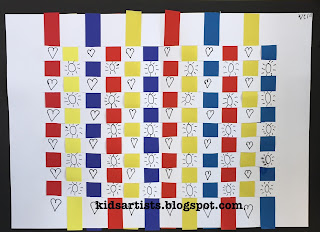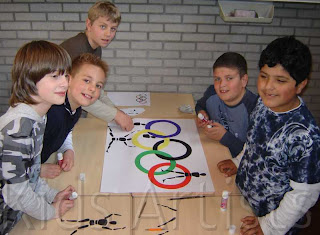Made by students of grade 3/4
Joan Miró's (Spain, 1893-1983) made paintings, sculptures, textile arts and theater. His paintings contain colorful organic shapes in bright colors: red, blue, yellow, green. The colored surfaces are outlined in black and frequently divided with black lines.
Show some of Miró's artwork. What do you see: bright colors, eyes, shapes outlined in black, divided surfases, stars. Talk about the difference between geometric and organic shapes. Talk about lines: straight, angular, rounded. What do you see in Miró's artwork?
The goal for a group of 4 students is: draw alternately lines on the white sheet with a permanent black marker. Make sure those lines look like Miró. Off course lines may cross! Then draw some elements Miró used too: eyes, stars, divided surfaces etc. Color the artwork. Be sure you're working with 4, so consult each other.
Ready? Sign the work with your personal signature in Miró style!



























.jpg)
 Start this lesson with the symbol of the Olympics: the colored rings. What do these rings mean? What colors do they have? How are they placed together?
Start this lesson with the symbol of the Olympics: the colored rings. What do these rings mean? What colors do they have? How are they placed together?

 Step two:
Every student takes a copy of the body and cuts every part of it. Then these bodyparts have to be pasted around, in, behind and in front of the Olympic rings.
Step two:
Every student takes a copy of the body and cuts every part of it. Then these bodyparts have to be pasted around, in, behind and in front of the Olympic rings.

